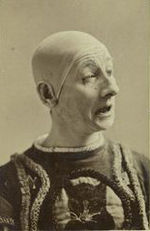History of clowns
It began with the singularity, a massive on-rush of energy, the cooling of star matter, the formation of galaxies, planets and their attendant satellites, through to the cooling of the earth, the oceans and the mountains, the development of the species, small fish things, lizards, monkeys and early humans, late humans, late humans with excuses, and then: the very first clown.
The Triassic Period[edit | edit source]
It was not until recently that clownologists associated the Triassic period with clowns. It was a commonly held view that the only interesting things in the Triassic period were rocks, fire, funny cars on stone wheels, large black obelisks, three dimensional dinosaurs, Sam Neill and apes. This point of view was shifted when some cave paintings were discovered in a cave, in southern France, which is where all the cave men put their paintings.
On the left of one painting is a worried looking mammoth- yeh, maybe because he is going extinct-, and on the right are a small group of figures driving around in a circle on a tricycle and making noises with cow horns. These are the very first recorded clowns.
Gregorian clowns[edit | edit source]
The strict codes and rules of the early medieval church meant that Gregorian clowns basically had a really hard time. The code of silence and complete ban on tricycles and cow horns by Pope Gregory XI only made things worse. Clowns were driven underground, and there are few remaining records of their activities as a result. The Bodleian library does, however, contain a document by a cousin of the Venerable Bede (his cousin Derek, the largely-ignorable Bede) who wrote:
Much singyng and adoraytion at the church today. We all stood in a lyne and stayed very styll. All except for Co-Co who crossed his eyes and wyggled his ears when the chaplain wasn't lookyng. This same Co-Co has recently entertained the idea of mayking a pye from custard and throwyng it at the parson. I praye to God that his soul be reedymed.
The Renaissance[edit | edit source]
It was during the Renaissance that mankind discovered that we are not situated right at the center of the universe, and that we are not even situated anywhere near the center of the universe, and that, in fact, that we are lucky to be situated anywhere, including Birmingham. Clowns became popular again. The awareness that we are a completely irrelevant chance event which is likely to be as easily extinguished just as it began can be mollified by watching someone with huge red shoes squirting someone else with water.
It was also around this time that clowning technology began to improve. The discovery of the rotten tomato in the Dutch East Indies, for example, brought a new dimension to European clown shows. A new standard was also introduced for the definition of custard. Previously, the question of what constituted custard had been left up to local village leaders, and a number of clowns died as a result of pies filled with rocks.
Contrary to popular myth, the red nose was not an invention of the Renaissance. This was invented by the Victorians, because their massive sexual repressions caused them to invent stuff like that and then to deny that they invented it at all.
The Enlightenment[edit | edit source]
The Enlightenment philosopher, Immanuel Kant, spent years in a shed developing some principles of rationalism and applying them to everything in the world. His principles turned out to be the most popular principles since: Never leave your pig alone under a tree in a thunderstorm - it doesn't make god any happier and it will probably kill the pig. This was to have an enormous impact on the world of clowning. Kant wrote in his journal:
My principles of rationalism must govern the behavior of all rational beings everywhere and at every stage of their life, except for clowns, who should be simply and quietly transformed into cubes by means of mathematics.
Following Kant's lead, people began to openly criticise clowns and throw balloons at them. They asked why, for example, every clown in the world was named 'Co-Co' and came to believe that this was because they had all descended from some common ancestor, who was probably very stupid and smelled funny.
The Romantic Age[edit | edit source]
This was the age of the solitary clown. There are many recorded instances of clowns wandering around valleys, frightening villagers and trying to make daffodils laugh. The painter Kasper Willhelm Friedrich famously depicted a lonely clown throwing a custard pie into a vast empty landscape of mountains and cliffs, with no trees or Mcdonalds or nothing in it, which is very sad.
It was around this time that the clown became the hero of the dispossessed. Karl Marx even flirted with the idea of becoming one before he decided that inventing socialism would bring him more free beer and peanuts. He kept the hat and the beard though.
The Modern Clown[edit | edit source]
The twentieth century saw the rise of the single greatest invention that the clown has ever seen: Television. It began with silent films. Many clowns found the transition from the circus to the big screen difficult, as producers put increasing demands on them, like throwing themselves off buildings and rolling under trains. In 1924, a number of clowns were killed when the tricycle they were riding accidentally rolled off the side of the Empire State Building. They were:
Co-Co
Co-Co
Co-Co
Co-Co
Co-Co
Co-Co
and
Graham
Their sacrifice will never be forgotten.
Clowns in space[edit | edit source]
In the future, obviously, clowns will colonise all of space. Huge custard pies made from neutronium will be thrown from planet to planet. Vast laser cow-horns will echo around galaxies. Clowns will travel through wormholes on water-proof tricycles. A piece of cheese will cost a million dollars. Postmen will use C5 electric cars. A banana will cost the same as a Ford Transit Van. But clowns will live on. Clowning will always survive. Until 2164 when they will all be wiped out by a mysterious virus.


